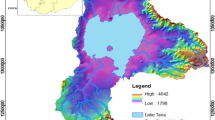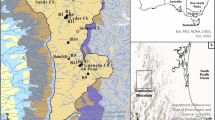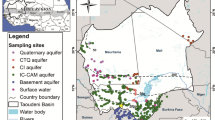Abstract
The Middle Awash basin is an arid region in Ethiopia where surface waters are scarce and local communities are dependent on groundwater resources for water supply. The complex hydrogeological system of this basin has been conceptualized. Multivariate statistical analysis of hydrochemical variables and water isotopes were used to study the rock–water interaction, geochemical reaction processes and the hydrological link between aquifers. Groundwaters from aquifers of the high-rainfall plateau bounding the rift are slightly mineralized, as well as depleted in δ18O and δD, and contain 3H above 0.8 TU. This suggests a low degree of rock–water interaction and that groundwater is under recharge from heavy rain that falls on surrounding highlands. On the other hand, groundwaters from aquifers of the rift floor are highly mineralized and show slight enrichment in δ18O and δD with positive oxygen shift, but contain 3H below 0.8 TU. The positive oxygen shift in rift floor groundwaters may be caused by the isotopic exchange of oxygen between groundwater and aquifer materials during rock–water interaction, whereas the low 3H content could be due to the decay of tritium along relatively long flow paths. The approach utilized in this study may be applicable to understanding hydrogeochemical processes in other complex volcanic terrains.
Résumé
Le bassin de l’Awash moyen est situé dans une zone aride en Ethiopie où les eaux de surface sont rares; les communautés locales dépendent des ressources en eaux souterraines pour leur alimentation. Le complexe hydrogéologique de ce bassin a été conceptualisé. Des analyses statistiques multi-variées des variables hydrochimiques et des isotopes de l’eau ont été utilisées afin d’étudier les interactions eau roche, les processus de réactions géochimiques, les relations hydrologiques entre les aquifères. Les eaux souterraines des aquifères du plateau bordant le rift, recevant de fortes précipitations, sont légèrement minéralisées et sont caractérisées également par l’absence de δ18O et δD; elles contiennent du tritium avec des valeurs au-dessus de 0.8 TU. Ceci suggère un faible degré d’interaction eau roche ainsi que les eaux souterraines sont alimentées par des infiltrations d’eau de pluie interceptée par les hauts plateaux environnants. D’un autre côté, les eaux souterraines des aquifères situés au cœur du rift sont fortement minéralisées et montrent un léger enrichissement en δ18O et δD avec un déplacement positif pour l’oxygène; elles contiennent des valeurs en tritium inférieurs à 0.8 TU. Le déplacement positif de l’oxygène dans les eaux souterraines des aquifères situés au cœur du rift peut être du à l’échange isotopique de l’oxygène entre l’eau souterraine et les matériaux constitutifs de l’aquifère au cours des réactions eau roche, alors que les faibles teneurs en 3H peuvent être dues à la décroissance du tritium le long des cheminements relativement long des écoulements. L’approche utilisée dans le cadre de cette étude peut être utilisée pour la compréhension des processus hydrochimiques dans d’autres complexes hydrogéologiques en terrains volcaniques.
Resumen
La cuenca media del Awash es una región árida en Etiopía donde las aguas superficiales son escasas y las comunidades locales dependen de los recursos de agua subterránea para su abastecimiento. Se ha conceptualizado el complejo sistema hidrogeológico de esta cuenca. Se usaron análisis estadísticos multivariados de variables hidroquímicas y isótopos del agua para estudiar la interacción agua–roca, los procesos de reacciones geoquímicas, y la relación hidrológica entre acuíferos. Las aguas subterráneas de los acuíferos de la meseta de alta precipitación que bordea el rift están ligeramente mineralizadas, así como empobrecidos en δ18O y δD, y contienen 3H por encima de 0.8 TU. Esto sugiere un bajo nivel de interacción agua – roca y que el agua subterránea está bajo recarga a partir de las intensas lluvias que caen en las tierras circundantes. Por el otra parte, las aguas subterráneas de los acuíferos en el piso del rift están altamente mineralizadas y muestran un leve enriquecimiento en δ18O y δD con un desplazamiento positivo del oxígeno, pero contiene 3H por debajo de 0.8 TU. El desplazamiento positivo del oxígeno en el piso del rift puede ser causado por el intercambio isotópico de oxígeno entre el agua subterránea y los materiales del acuífero durante la interacción agua–roca, mientras que el bajo contenido de H podría deberse a la desintegración del tritio a lo largo de trayectorias de flujo relativamente largas. El enfoque utilizado en este estudio puede ser aplicable para entender los procesos hidrogeoquímicos en otros terrenos volcánicos complejos.
摘要
埃塞俄比亚Awash中部盆地是一个干旱区,地表水稀少,当地群落用水主要依靠地下水资源。盆地复杂的水文地质系统已经被概念化。本文使用水化学变量的多元统计分析以及水同位素方法研究水岩相互作用、地球化学反应过程以及不同含水层之间的水力联系。该高原降雨量较高,以裂隙为边界,含水层中的地下水轻微矿化,δ18O和 δD贫化,氚含量高于0.8 TU。这表明,本区水岩相互作用程度很低,暴雨落到周围高地并补给地下水。另一方面,裂隙地面含水层中的地下水矿化度高,δ18O和 δD轻微富集,且氧正漂移,氚含量低于0.8 TU。裂隙地面的地下水正向氧漂移可能由于水岩相互作用时地下水及含水层介质之间氧同位素交换引起,低的氚含量是由于沿着相对长的流线上氚衰减引起的。在本研究中使用的方法可适用于其他复杂火山地形,了解其水文地球化学过程。
Riassunto
Il bacino del Awash centrale è situato nel regione arida in Etiopia in cui le acque di superficie sono limitate e le comunità locali dipendono dalle risorse idiriche freatica. Il sistema idrogeologico complesso di questo bacino è stato concettualizzato. L'analisi statistica sui variabili idrochimici e degli isotopi dell'acqua è stata usata per studiare l'interazione tra roccia e acqua, includendo i processi geochimici di reazione ed il collegamento idrologico fra gli strati acquiferi. Le acque freatiche dagli strati acquiferi dell’ altopiano sono pocco mineralizzate, come pure l’ impoverito del δ18O e δD e contengono 3H al di sopra di 0.8 TU. Ciò suggerisce che un basso grado di interazione tra roccia e acqua, e che le acque freatiche sono sotto ricarica da pioggia persistente che cade sulle alture circostanti. Da un lato, le acque freatiche dagli strati acquiferi del Rift sono altamente mineralizzate e mostrano un lieve arricchimento sul δ18O e δD con lo spostamento positivo dell'ossigeno, ma contengono 3H al di sotto di 0.8 TU. La variazione positiva dell’ossigeno nelle acque freatiche del Rift può essere causata tramite uno scambio isotopico di ossigeno fra acqua freatica ed i materiali dello strato acquifero durante l’interazione tra roccia e acqua, mentre il basso contenuto di 3H potrebbe essere dovuto decadimento del trizio con percorsi di flusso relativamente lunghi. I metodi utilizzati in questo studio possono essere usati per la comprensione dei processi di idrogeochimica in altri terreni vulcanici complessi.
Resumo
A bacia do Médio Awash é uma região árida na Etiópia onde as águas superficiais são escassas, pelo que as comunidades locais estão dependentes de recursos de águas subterrâneas para o seu abastecimento. Foi conceptualizado o complexo sistema hidrogeológico da bacia. Utilizou-se a análise estatística multivariada de variáveis hidroquímicas e de isótopos na água para estudar a interacção água-rocha, os processos de reacções geoquímicas e a ligação hidrológica entre aquíferos. As águas subterrâneas dos aquíferos dos planaltos com elevada precipitação que delimitam o rift são ligeiramente mineralizadas e empobrecidas em δ18O e δD, e contêm 3H acima de 0.8 UT. Isso sugere que há um baixo grau de interacção água–rocha e, ainda, que as águas subterrâneas sofrem recarga a partir da elevada precipitação nos planaltos vizinhos. Por outro lado, as águas subterrâneas de aquíferos da base do rift são altamente mineralizadas e mostram enriquecimento ligeiro em δ18O e δD, com deslocamento positivo do oxigénio, mas contém 3H abaixo de 0.8 UT. O deslocamento positivo de oxigénio nas águas subterrâneas da zona da base do rift pode ser causada pela troca isotópica de oxigénio entre as águas subterrâneas e o material litológico do aquífero durante a interacção água–rocha, enquanto que o teor baixo de 3H poderia dever-se à desintegração do trítio ao longo de caminhos de fluxo relativamente longos. A abordagem utilizada neste estudo pode ser aplicável para a compreensão dos processos hidrogeoquímicos de outros terrenos vulcânicos complexos.










Similar content being viewed by others
References
Abebe B, Boccaletti M, Mazzuoli M, Bonini M, Tortorici L, Trua T (1998) Geological map of the Lake Ziway–Asela region (Main Ethiopian Rift), scale 1:50,000. Cons. Naz. Delle Ric., A. R. C. A., Florence, Italy
Abebe T, Mazzarini F, Innocenti F, Manetti P, Pecksay Z (2005) Geological map (1:200,000) of the northern Main Ethiopian Rift and its implications for the volcano-tectonic evolution of the rift. Geological Society of America, Map and Chart Series MC1109
Abebe B, Acocella V, Korme T, Ayalew D (2007) Quaternary faulting and volcanism in the Main Ethiopian Rift. J Afr Earth Sci 48:115–124
Abiye TA, Haile T (2008) Geophysical exploration of the Boku geothermal area, Central Ethiopian Rift. Geothermics 37(6):586–596
Acocella V, Korme T, Salvini F, Funiciello R (2002) Elliptic calderas in the Ethiopian Rift: control of pre-existing structures. J Volcanol Geotherm Res 119:189–203
Alemayehu T, Ayenew T, Kebede S (2006) Hydrogeochemistry and lake level changes in the Ethiopian Rift. J Hydrol 316:290–300
Anderson TW (1984) An introduction to multivariate statistical analysis. Wiley, New York, 675 pp
Appelo C, Postma D (1993) Geochemistry, groundwater and pollution. Balkema, Rotterdam, 536 pp
Arthur N, Roisenberg A, Fachel J, Mesquita G, Danieli C (2008) Fluoride characterization by principal component analysis in the hydrochemical facies of Serra Geral aquifer system in Southern Brazil. Anais da Academia Braseleira de Clèncias 80(4):693–701
Ayenew T, Kebede S, Abiye TA (2008) Environmental isotopes and hydrochemical study as applied to surface water and groundwater interaction in Awash basin. Hydrol Process J 22:1548–1563
Babulal D, Talukdar J, Sarma S, Gohain B, Roin K, Himangshu B, Subhash C (2003) Fluoride and other inorganic constituents in groundwater of Guwahati, Assam, India. Curr Sci 85:5–10
Boccaletti M, Mazzuoli R, Bonini M, Trua T, Abebe B (1999) Plio-Quaternary volcanotectonic activity in the northern sector of the Main Ethiopian Rift: relationships with oblique rifting. J Afr Earth Sci 29(4):679–698
Brown C (1998) Applied multivariate statistics in geohydrology and related sciences. Springer, New York, 248 pp
Chenini I, Khemiri S (2009) Evaluation of groundwater quality using multiple linear regression and structural equation modelling. Int J Environ Sci Technol 6(3):509–519
Chernet T, Travi Y, Valles V (2001) Mechanism of degradation of the quality of natural water in the lakes region of the Ethiopian Rift Valley. Water Res 35:2819–2832
Clark ID, Fritz P (1997) Environmental isotopes in hydrology. Lewis, New York, 328 pp
Dansgaard W (1964) Stable isotopes in precipitation. Tellus 16:436–468
Davis J (2002) Statistics and data analysis in geology. Wiley, New York
Demirel Z, Guler C (2006) Hydrogeochemical evolution of groundwater in Mediterranean coastal aquifer, Mersin–Erdemli basin (Turkey). Environ Geol J 49:477–487
Drever J (1982) The geochemistry of natural waters. Prentice-Hall, Englewood Cliffs
Ebinger C, Casey M (2001) Continental breakup in magmatic provinces: an Ethiopian example. Geology 29(6):527–530
Edmunds W, Darling D, Kinniburgh KS, Mahgoub S (1992) Sources of recharge at Abu Deliag, Sudan. J Hydrol 13:1–24
Fausto G, Giorgio C, Rocco F, Salvatore I (2006) Chemical and isotopic composition of waters and dissolved gasses in some thermal springs of Sicily and adjacent volcanic islands, Italy. Appl Geophys 163:781–807
Fisher R, Stephen M, William F (1997) Hydrochemical evolution of sodium-sulfate and sodium-chloride groundwater beneath the northern Chihuahuan Desert, Trans-Pecos, Texas, USA. Hydrogeol J 5:4–16
Freeze RA, Cherry JA (1979) Groundwater. Prentice-Hall, Englewood Cliffs
Furi W (2010) Hydrogeology of complex volcanic systems in continental rifted zone. Integrated geophysical, geochemical, and hydrodynamic approach. Middle Awash basin, Main Ethiopian Rift, Ethiopia. PhD thesis, Faculty of Basic and Applied Sciences, University of Poitiers, Poitiers, France
Furi W, Razack M, Haile T, Abiye TA, Legesse D (2011a) The hydrogeology of Adama–Wonji basin and assessment of groundwater level changes in Wonji wetland, Main Ethiopian Rift: results from 2D tomography and electrical sounding method. J Environ Earth Sci 62(6):1323–1335
Furi W, Razack M, Abiye TA, Ayenew T, Legesse D (2011b) Fluoride enrichment mechanism and geospatial distribution in the volcanic aquifers of the Middle Awash basin, Northern Main Ethiopian Rift. J Afr Earth Sci 60:315–327
Gat J (1996) Oxygen and hydrogen isotopes in hydrologic cycle. Annu Rev Earth Planet Sci 24:225–262
Handa BK (1975) Geochemistry and genesis of fluoride containing ground waters in India. Ground Water 13:275–281
Helena B, Pardo R, Vega M, Barrado E, Femandez J, Fernandez L (2000) Temporal evolution of groundwater composition in an alluvial aquifer (Pisuerga River, Spain) by principal component analysis. Water Res 34:807–816
Hem JD (1992) Study and interpretation of the chemical characteristics of natural water, 3rd edn. USGS Paper 2254, 264 pp
IAEA (2006) Global Network of Isotopes in Precipitation (GNIP) and Isotope Hydrology Information System (ISOHIS). International Atomic Energy Agency, Vienna. http://isohis.iaea.org/. Accessed 18 July 2007
Join J, Coudray J, Longworth K (1997) Using principal components analysis and Na/Cl ratios to trace groundwater circulation in volcanic island. The example of Reunion. J Hydrol 190(2):1–18
Kebede S, Travi Y, Alemayehu T, Ayenew T (2005) Groundwater recharge, circulation and geochemical evolution in the source region of Blue Nile River, Ethiopia. Appl Geochem 20:1658–1676
Kebede S, Yves T, Asrat A, Alemayehu T, Ayenew T, Tessema Z (2008) Groundwater origin and flow along selected transects in Ethiopian Rift volcanic aquifers. Hydrogeol J 16:55–73
Keir D, Ebinger C, Stuart G, Daly E, Ayele A (2006) Strain accommodation by magmatism and faulting as rifting proceeds to breakup: seismicity of the northern Ethiopian rift. J Geophys Soc Am 11:949–952
Kendall C, McDonnell J (1998) Isotope tracers in catchment hydrology. Elsevier Science, Amsterdam, pp 51–86
Keranen K, Klemperer S (2007) Discontinuous and diachronous evolution of the Main Ethiopian Rift: implication for development of continental rift. Earth Planet Sci Lett 265:96–11
Lambrakis N, Antonakos A, Panagopoulos G (2004) The use of multicomponent statistical analysis in hydrogeological environmental research. Water Res 38:1862–1872
Melloul A (1995) Use of principal component analysis for studying deep aquifers with scarce data: application to the Nubian sandstone aquifer, Egypt and Israel. Hydrogeol J 3(2):19–39
Melloul A, Collin M (1992) The principal component statistical method as a complementary approach to geochemical methods in quality factor identification: application to the coastal plain aquifer of Israel. J Hydrol 140:49–73
Meng S, Maynard J (2001) Use of statistical analysis to formulate conceptual models of geochemical behaviour: water chemical data from the Botucata aquifer in Sao Paulo State, Brazil. J Hydrol 250:78–97
Nir A (1964) On the interpretation of tritium age measurements of groundwater. J Geophys Res 69:2589–2595
Papatheodorou G, Lambrakis N, Panagopoulos G (2007) Application of multivariate statistical procedures to the hydrochemical study of coastal aquifers: an example from Crete, Greece. Hydrol Processes 21:1482–1495
Peccerillo A, Barberio MR, Yirgu G, Ayalew D, Barbieri M, Wu TW (2003) Relationships between mafic and peralkaline silicic magmatism in continental rift settings: a petrological, geochemical and isotopic study of the Gedemsa Volcano, Central Ethiopian Rift. J Petrol 44(11):2003–2032
Rozanski K, Araguas-Araguas L, Gonfiantini R (1996) Isotope patterns of precipitation in the East African region. In: Johnson TC, Odada E (eds) The climatology, palaeoclimatoloy, paleoecology of the East African lakes. Gordon and Breach, Toronto, pp 79–93
Ruiz F, Gomis V, Blasco P (1990) Application of factor analysis to the hydrochemical study of a coastal aquifer. J Hydrol 119:169–177
Shanko D, Camberlin P (1998) The effects of the southwest Indian Ocean tropical cyclones on Ethiopian drought. Int J Climatol 18:1373–1388
Sklash M (1990) Environmental isotope studies of storm and snowmelt runoff generation. In: Anderson MG, Burt TP (eds) Process studies in hill-slope hydrology. Wiley, Chichester, pp 401–435
Tadesse T (1994). The influence of the Arabian Sea storms: depressions over the Ethiopian weather. Proceedings of the International Conference on Monsoon Variability and Prediction, ICTP, Trieste, 9–13, World Meteorological Organization, TD 619, pp 228–236
TekleHaimanot R, Fekadu A, Bushra B (1987) Endemic fluorosis in the Ethiopian Rift Valley. Trop Geogr Med 39(3):209–217
Voudouris K, Panagopoulos A, Koumantakis J (2000) Multivariate statistical analysis in the assessment of hydrochemistry of the Northern Korinthia alluvial aquifer system (Peloponnese, Greece). Nat Resour Res 9:135–145
Wang Y, Ma T, Luo Z (2001) Geostatistical and geochemical analysis of surface water leakage into groundwater on a regional scale: a case study in the Liulin karst system, north western China. J Hydrol 246(1–4):223–234
WoldeGabriel G, Walter RC, Aroson JL, Hart WK (1992) Geochronology and distribution of silicic volcanic rocks of Pliopleistocene age from the central sector of the Main Ethiopian Rift. Quat Int 13(14):69–76
Yirgu G, Dereje A, Peccerillo MR, Barberio C, Donati P (1999) Fluorine and chlorine distribution in the volcanic rocks from the Gedemsa volcano, Ethiopian Rift Valley. Acta Vulcanologica 11(1):169–176
Acknowledgements
This study was undertaken in the framework of the MAWARI research project (Sustainable Management of Water Resource in the East African Rift system) funded by the French Ministry of Foreign and European Affairs. CIFEG (Centre International pour la Formation et les Echanges en Géosciences) is highly acknowledged for managing the grant and facilitating field work in Ethiopia. The Oromia Regional Water Bureau, Department of Earth Science at Addis Ababa University and Water Works Design and Supervision Enterprise (WWDSE) are warmly thanked for their valuable contributions in providing data and unreserved cooperation during the field work.
Author information
Authors and Affiliations
Corresponding author
Rights and permissions
About this article
Cite this article
Furi, W., Razack, M., Abiye, T.A. et al. Hydrochemical characterization of complex volcanic aquifers in a continental rifted zone: the Middle Awash basin, Ethiopia. Hydrogeol J 20, 385–400 (2012). https://doi.org/10.1007/s10040-011-0807-1
Received:
Accepted:
Published:
Issue Date:
DOI: https://doi.org/10.1007/s10040-011-0807-1




